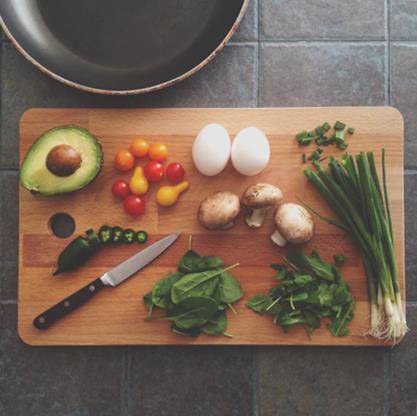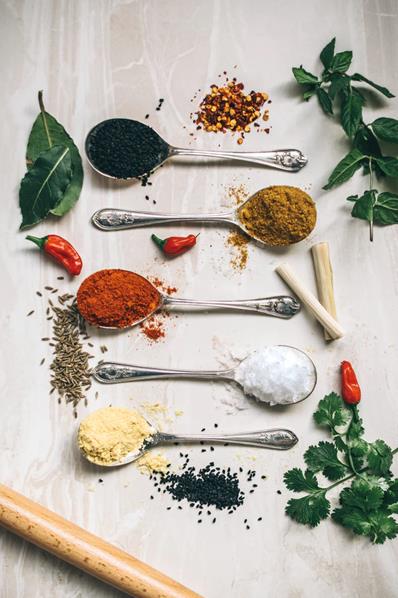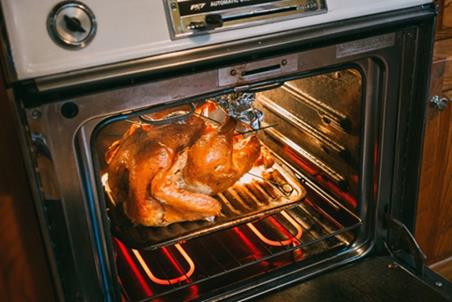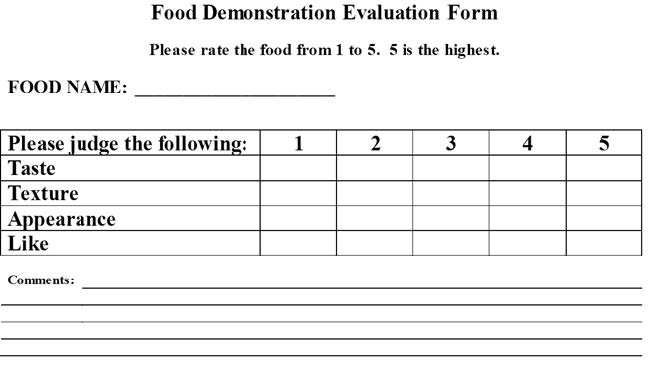Recipe Development
This publication gives insight on the proper construction of a recipe and its key elements, best practices for recipe development, food tasting and evaluation.
What is a recipe and its purpose?
A recipe is simply defined as a set of instructions with a list of ingredients used to prepare a particular food, dish or drink. People use recipes to replicate foods they enjoy that they otherwise do not know how to make. Chefs use recipes to make sure a dish tastes the same each time it is ordered.
To develop a good recipe, it should be tested to ensure consistent and reliable outcomes, regardless of the person following the recipe instructions. With a properly written recipe, its ingredients and serving size are exact and measured accurately. Based on this information, a nutrient analysis can be done to evaluate the nutrition content of the dish, which is important information for some.
How can we start writing a recipe?
First of all, identify the source of inspiration. It can be an original recipe based on personal experiences or an adaptation from someone else's original recipe. If the recipe is taken or adapted from someone else's, proper attribution should be given after the title or at the end of the recipe (Duyff, 2013). Recipes for the most part are not copyrightable, as the ingredient list and directions are not protected under copyright. However, a recipe’s images and creative expression through its written description or explanations may be protected (U.S. Copyright Office, 2021, p. 3).
When writing a recipe, identify the target audience. This will aid in tailoring recipe details, such as budget or preparation methods, to suit the target audience’s age group or abilities. Seasonality of the ingredients may also affect the outcome of the dish. For example, a mango smoothie may not taste as sweet and flavorful if the mangoes were sour and not in season.
What are the elements of a well-constructed recipe?
Recipe Title - The title can be descriptive or creative, but the most important thing is to represent the dish. It is not necessary to include every ingredient in the title. For example, a recipe name could be "Baked orange chicken with brown rice." This recipe title is descriptive, as it shows the chicken is baked, orange sauce is used, and it comes with brown rice. However, it can be more creative by using "glazed," such as "Orange-glazed chicken with brown rice."
Yield - The yield is the amount of final product that the recipe will produce. It can be expressed as a total volume, weight or number, such as 12 muffins. The yield amount should look realistic and easy to measure. For example, if a recipe yields 16 tablespoons of salad dressing, it should be converted to say 1 cup, because there are 16 tablespoons in one cup. If the yield amount looks unrealistic, for example, 12½ muffins, the ingredient amounts or the serving size will need to be adjusted to yield a whole number.
Serving Size - The serving size is the amount of food that makes up one serving of the recipe. This amount is relevant for reasons such as food cost and nutrient analysis. A nutrient analysis can yield helpful information for the consumers when they eat a varied amount of food made from the recipe. Therefore, it is essential to list the ingredients in specific amounts and carefully measure the yield and serving size, as they both contribute directly to the outcome of the nutrient analysis.
Additional Prep - Other elements to include are preparation time, cooking time and temperature. This information is helpful because it tells the readers the appropriate temperature and amount of time needed for the highest quality product. It may be listed at the top of the page, so it is easy to find. Readers can then determine when to start preparation and preheating the oven without reading the entire recipe.
Ingredient List - The ingredient list is one of the most critical parts of a recipe. The ingredients should be listed in chronological order, with the ingredient used first at the very top of the list (Palmer, 2020). According to Drumm (2020), list ingredients in descending volume order if many ingredients are used in the same step. If an ingredient is used twice in a recipe, list the ingredient with “divided.” Each ingredient should also be on its own line.

Measurements can be critical to the recipe’s outcome. It is good practice to avoid abbreviating and instead write out units, such as tablespoons, cups or ounces. Doing this helps people who are unfamiliar with the abbreviations and makes it easier to follow the recipe correctly. However, if abbreviations are preferred, use them consistently for every ingredient and recipe to avoid confusion. Also, writing two numbers in a row when a package size is involved should be avoided. The second number or package size should be in parentheses (Drumm, 2020). For example, list the item as “2 (4-ounce) beef tenderloins” or “1 (15-ounce) can cream of chicken.”
The ingredient list also specifies the type and form of ingredients. If a description of a basic preparation for an ingredient is included, cooking terms should be used, such as sliced, chopped, minced, julienned, cubed and ground. These are terms that are straight to the point and precise (Duyff, 2013).
If using store-bought items, include whether they should be fresh, canned or frozen. This information is relevant because 1 cup of frozen green beans may not be the same amount as 1 cup of canned or fresh green beans.
The form of wording for an ingredient also matters (Drumm, 2020). For example, "1 cup almonds, chopped" versus "1 cup chopped almonds" may look identical in terms of the ingredient, amount and preparation form. However, "1 cup chopped almonds" is actually measuring a cup of almonds that have already been chopped, whereas in "1 cup almonds, chopped," a cup of whole almonds needs to be measured out first and then chopped. Again, it is mainly for the accuracy of measurements to ensure an expected outcome. For meats and seafood, information on whether the chicken breast is skinless, skin–on or boneless, and whether the shrimp is deveined and peeled should be included. However, if an ingredient needs further preparation, that information should be included within the directions.
Directions - The list of directions can also be called instructions or procedures. This section is where the steps on how to make the dish are listed. Recipe steps should be concise, precise and logical. For example, if the oven needs to be preheated to a specific temperature, that should be written in step one. Ingredient names in the directions can be shortened, since they have already been mentioned previously in the ingredient list (Drumm, 2020). For example, a step should say, "Cook the shrimp" instead of "Cook the deveined, peeled shrimp." It is good practice to give a detailed description of the tools or equipment needed when first mentioned in the steps. For example, when introducing a piece of equipment the first time in the recipe, it should say, "Use a 13-by-9-inch glass baking dish." After that, if it is used again, it can simply be called the "baking dish."

Include the cooking method, equipment, temperature and cooking duration, and if possible, the visual indicators of doneness (Duyff, 2013). For example, directions should say, "Roast the chicken in an oven for 45 minutes at 400 F, or until internal temperature of chicken reaches 165 F on a calibrated thermometer." For stovetops, it could say, "Sauté onions in a large sauté pan over medium-high heat for about 10 minutes or until caramelized."
Provide food-safety tips to help increase the likelihood that professional and home cooks alike will increase food-safety behaviors. For example, “Wash cutting board after touching raw meats.” The Safe Recipe Style Guide is an example of a resource that provides simple food-safety instructions that may be added to a recipe (Partnership for Food Safety Education, 2020).
Using appropriate cooking terms will help make steps as clear and short as possible. For example, instead of writing "Let the chicken cook in the sauce at low heat for 45 minutes," it can be rephrased as "Simmer the chicken for 45 minutes."
A recipe should always end with a simple serving instruction (Drumm, 2020). It can be a simple sentence, such as "Serve immediately" or "Allow it to cool completely before serving." Plating instructions can include garnishes, such as green onions, cilantro, lemon juice and sesame seeds.
Nutritional Information
Nutritional information is an invaluable element because, like a packaged food, the reader will be able to find information on the dish's nutritional content and decide whether to make and eat it or how much to eat. The analysis is done on the entire yield but reported per serving, and nutrients to report include calories, total fat, saturated fat, trans fat, cholesterol, sodium, total carbohydrate, dietary fiber, total and added sugars, protein, vitamin D, calcium, iron, and potassium. This list of nutrients is the same as the list of nutrients that appear on nutrition facts labels on packaged foods. Like nutrition facts labels, these nutrients should be reported in a nutrient analysis, as they are considered significant to either limit or increase their intake. The intake of cholesterol, sodium, trans fat and saturated fat should be limited; while intake of dietary fiber, vitamin D, calcium, iron and potassium should be increased (U.S. Food and Drug Administration, 2020).
Essential micronutrients, such as vitamins and minerals that are more than 20% daily value, considered an excellent source, should also be reported. The Office of Dietary Supplements website is a credible resource for information on vitamins and minerals. Dietary analysis software may be a time- saving, accurate and easy-to-use tool to analyze the nutritional content of a recipe.
Description or Headnote - Another good element to have is the recipe description or headnote. In just one or two sentences, the description introduces the dish (Palmer, 2020). It is a way to give the recipe character, and it can also grab the reader's attention a little better than just the recipe title. This section is where tips and tricks may be shared. For example, it can include storage tips, suggestions for reheating, alternative ingredients, or dish and drink pairings. Finally, it is also a great place to point out healthful information.
Food Testing and Evaluation
Lastly, when everything has been planned out, test the recipe. A good recipe should be tested enough times to ensure the steps are understandable and the end product is delicious. It is important to document the whole cooking process when testing to record what has changed or has not changed, including the measurements of every single ingredient. It is beneficial for others to try the dish to get some opinions and constructive feedback. Restaurants usually use this method by asking customers to try their new dishes to determine if a seasonal item will be popular enough to stay on the menu or it needs to be improved or changed.
Testing the recipe product is an integral part of recipe development that ensures the product is of good quality. Sensory evaluation is a scientific method to measure and analyze the quality of food based on human senses, which are touch, sight, hearing, smell and taste.
When food is evaluated based on these senses, a numerical scale is usually used to rate the food in various categories and measures the final result. When rating the appearance, considerations may include the color of the food, size, shape and texture, and if it looks appetizing overall. For smell, any scent or aroma coming from the food, if something is rich or light, and is fresh or not fresh, will contribute to the score. For hearing, there may be crunchy, sizzling or popping sounds. Touch is rated on the texture of the food and the mouthfeel, including if the food is smooth, gritty or chunky. Finally, for taste, the overall flavor is rated based on a combination of five taste types: salty, sweet, bitter, sour and umami.
As sensory evaluation is a scientific method of measuring food quality, this method can be relied on to improve the quality and consistency without any biases. The results can be reviewed and analyzed to identify factors that influence the consumers' preferences. Results can also be analyzed to see how it performs against competitors’ products. Comparing two food items based on the same requirements will show exactly what is different with each food. It is useful when developing a healthier version of a recipe, but still ensures it tastes the same as the original.

Figure 1 depicts a sample evaluation form. Every sensory evaluation form looks different, as it caters to the need of the tester. This evaluation has ratings from 1 to 5 in the categories of taste, texture, appearance and like. Other sensory evaluation forms may include aroma as well. There should always be a comments section to include an explanation or further information to support the numbers or points given. When used to select dishes for a menu, many dishes may be evaluated at the same time to be ranked with each other with their final scores.
Conclusion
In summary, a well–developed recipe should include key elements to help the user decide whether or not they want to attempt producing the recipe and if it fits their individual needs, including: recipe title, yield, serving size, nutrient analysis, preparation and cooking time. An accurate ingredient list and clear directions that specify needed equipment are also of the utmost importance to ensure the creator will successfully produce the recipe. Finally, testing and evaluation are needed to ensure the recipe works and meets expectations.
Well–constructed and kitchen–tested recipes help both cooking novices and experienced chefs prepare delicious and nutritious meals for themselves and others. Good recipes help with meal planning, while keeping time, money, food seasonality and other considerations in mind. Imparting the joy of cooking and expanding the culinary skill set of the at–home cook can help improve the diet, save money and enhance social connections, helping to create a positive impact on health and overall well–being.
References
- Drumm, M. (2020, July 30). How to Write a Recipe: The 4 Key Elements of a Great Cookbook Recipe. TCK Publishing. Retrieved August 10, 2020, from https://www.tckpublishing.com/how-to-write-a-recipe/
- Duyff, R. L. (2013, October 28). From Kitchen to Keyboard. Food & Nutrition Magazine. Retrieved August 10, 2020, from https://foodandnutrition.org/November-December-2013/From-Kitchen-to-Keyboard/
- Palmer, S. (2020, July 6). Rules for Good Recipe Writing. Sharon Palmer, The Plant Powered Dietitian. Retrieved August 10, 2020, from https://sharonpalmer.com/rules-for-good-recipe-writing/
- Partnership for Food Safety Education. (2020). Safe Recipe Style Guide. Retrieved October 28, 2021, from https://www.saferecipeguide.org/guide/
- U.S. Copyright Office. (2021). Works Not Protected by Copyright. Circular 33. Retrieved August 17, 2021, from https://www.copyright.gov/circs/circ33.pdf
- U.S. Food and Drug Administration. (2020, March 11). How to Understand and Use the Nutrition Facts Label. Retrieved August 10, 2020, from https://www.fda.gov/food/new-nutrition-facts-label/how-understand-and-use-nutrition-facts-label
Aurora Calvillo Buffington, Ph.D., Public Health Nutrition Specialist1
Sally Li, Dietetic Intern2
Buffington, A., and Li, S.
2021,
All About Recipes Part I,
Extension | University of Nevada, Reno


